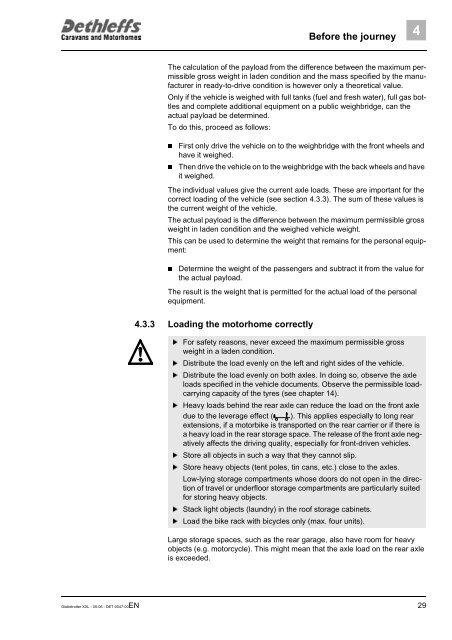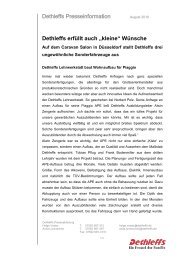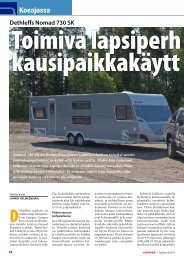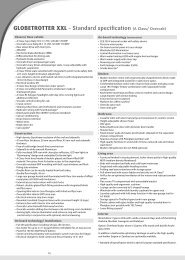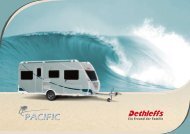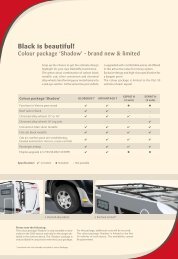User Manual XXL Globetrotter 2006 - Dethleffs
User Manual XXL Globetrotter 2006 - Dethleffs
User Manual XXL Globetrotter 2006 - Dethleffs
Create successful ePaper yourself
Turn your PDF publications into a flip-book with our unique Google optimized e-Paper software.
Before the journey<br />
4<br />
The calculation of the payload from the difference between the maximum permissible<br />
gross weight in laden condition and the mass specified by the manufacturer<br />
in ready-to-drive condition is however only a theoretical value.<br />
Only if the vehicle is weighed with full tanks (fuel and fresh water), full gas bottles<br />
and complete additional equipment on a public weighbridge, can the<br />
actual payload be determined.<br />
To do this, proceed as follows:<br />
First only drive the vehicle on to the weighbridge with the front wheels and<br />
<br />
have it weighed.<br />
Then drive the vehicle on to the weighbridge with the back wheels and have<br />
<br />
it weighed.<br />
The individual values give the current axle loads. These are important for the<br />
correct loading of the vehicle (see section 4.3.3). The sum of these values is<br />
the current weight of the vehicle.<br />
The actual payload is the difference between the maximum permissible gross<br />
weight in laden condition and the weighed vehicle weight.<br />
This can be used to determine the weight that remains for the personal equipment:<br />
Determine the weight of the passengers and subtract it from the value for<br />
<br />
the actual payload.<br />
The result is the weight that is permitted for the actual load of the personal<br />
equipment.<br />
4.3.3 Loading the motorhome correctly<br />
For safety reasons, never exceed the maximum permissible gross<br />
<br />
weight in a laden condition.<br />
Distribute the load evenly on the left and right sides of the vehicle.<br />
<br />
Distribute the load evenly on both axles. In doing so, observe the axle<br />
<br />
loads specified in the vehicle documents. Observe the permissible loadcarrying<br />
capacity of the tyres (see chapter 14).<br />
Heavy loads behind the rear axle can reduce the load on the front axle<br />
<br />
due to the leverage effect ( ). This applies especially to long rear<br />
extensions, if a motorbike is transported on the rear carrier or if there is<br />
a heavy load in the rear storage space. The release of the front axle negatively<br />
affects the driving quality, especially for front-driven vehicles.<br />
Store all objects in such a way that they cannot slip.<br />
<br />
Store heavy objects (tent poles, tin cans, etc.) close to the axles.<br />
<br />
Low-lying storage compartments whose doors do not open in the direction<br />
of travel or underfloor storage compartments are particularly suited<br />
for storing heavy objects.<br />
Stack light objects (laundry) in the roof storage cabinets.<br />
<br />
Load the bike rack with bicycles only (max. four units).<br />
<br />
Large storage spaces, such as the rear garage, also have room for heavy<br />
objects (e.g. motorcycle). This might mean that the axle load on the rear axle<br />
is exceeded.<br />
<strong>Globetrotter</strong> <strong>XXL</strong> - 05-06 - DET-0047-00EN<br />
29


